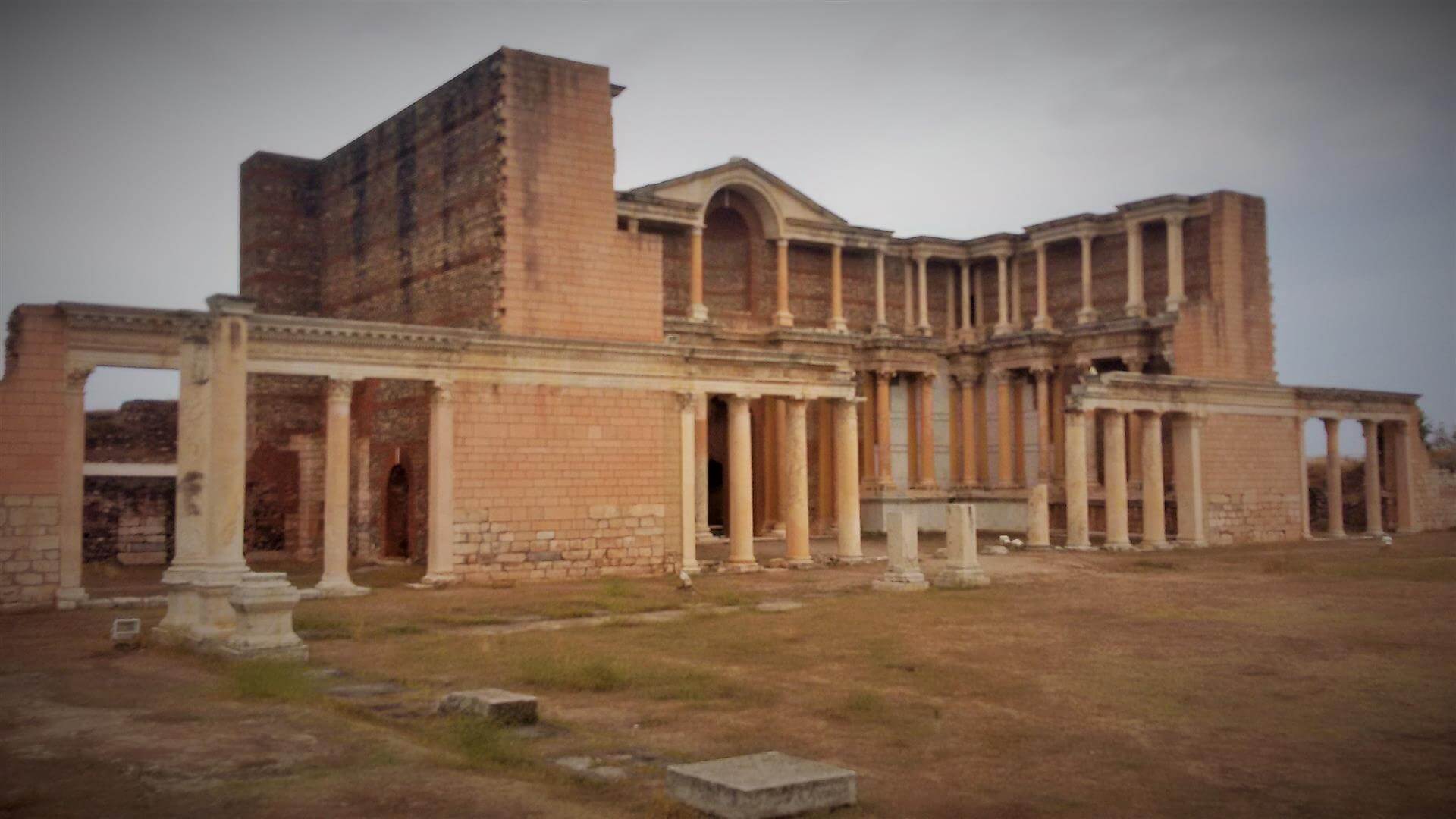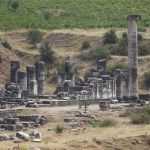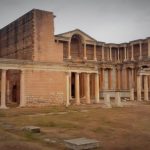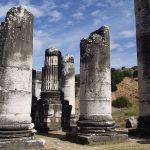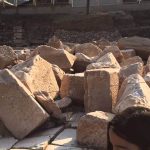HISTORY OF SARDIS
Sardis lies about 90 km. inland from the Aegean, in the upper Hermos valley. Its early history is hard to establish. Homer mentions the site in the Iliad as the territory of Maeonians. Herodotus states that Greek warriors, “sons of Heracles” established a kingdom there. As the Hittite Empire declined, Lydians, a people of obscure origin, speaking an Indo-European language, migrated into the region and established their rule over the indigenous people. Herodotus described Lydia as “a fertile country rich in gold.” Indeed, Sardis, drawing plentiful gold from the river Pactolus (Sart Cayi), a tributary of the Hermos (Gediz), was renowned for its wealth. The site possessed several links with Greek mythology. Euripides, in his play the Bacchae, identified snow-capped mount Tmolos that overlooks Sardis as the birthplace of Dionysus and it was connected with the mythical ruler Tantalos, whose son Pelops founded the Peloponnese and the royal dynasty of Mycenae. The region was also associated with the Anatolian earth mother goddess Cybele, whom the Greeks transformed into their goddess Artemis. While the sources of Homer and Herodotus in ancient myths were often contradictory, discoveries of Mycenean and Greek Prato-geometric pottery confirm a Hellenic presence in Lydia from about 1200- 900 BCE.
.
In the Archaic era the Lydians gradually absorbed Greek culture and wrote in the Greek alphabet. By the sixth century BCE Sardis was economically powerful, minting the world’s first coins, manufacturing valuable goods and trading widely. The earliest coins were made of electrum, a naturally occurring alloy of gold and silver; later they issued them in both pure gold and silver. Archaeological evidence of gold-working industries near the Pactolus supports the belief that the river was a major source of the precious metal.
.
A series of strong kings fought to protect and expand their territory. King Gyges (680-652) resisted the Cimmerians, a barbarian tribe who had overrun Phrygia and sacked Sardis. His son Ardys (651-625) defeated them decisively and also occupied the Ionian Greek city of Priene.
.
Under the ambitious King Alyattes II (609-650) the Lydians captured Smyrna in the west and the Phrygian capital Gordion in the east. They also made peace with the Medes, former adversaries further to the east. These kings were buried under vast tumuli that can be seen to the north of the site. Herodotus described the largest one as equal to the pyramids of Egypt.
.
King Croesus (595-547? BCE), whose wealth gave rise to the expression “rich as Croesus,” overpowered the remaining Greek cities on the Aegean coast and ruled them from Sardis. He was a relatively benign ruler, who admired the Greeks, and did not harshly oppress his subjects. Indeed, he became their benefactor when he sponsored the reconstruction of the great Temple of Artemis at Ephesus, which had been ruined by a flood. Little writing by Lydians survives to shed light on their culture but Greek writers left records. Several Greek poets, philosophers, scientists, and musicians travelled to Sardis. Even the Athenian statesman Solon visited and the great philosopher Thales of Miletus may have served as an advisor to Croesus. In addition Greek artisans and scholars flocked there to work for the wealthy ruler. The Lydians developed a reputation for music but perhaps their most enduring inventions were the games of knucklebones and dice.
.
Croesus could have created a brilliant empire if success had not gone to his head. He felt threatened by the expansion of the Persian Empire under Cyrus the Great and, not content with merely defending his borders, he set his sights on conquest. He consulted the oracle of Apollo at nearby Didyma, to which he had already made valuable donations, but received no clear reply. The Delphic oracle, also receiving his ostentatious gifts, pronounced that if he waged war on the Persians a great empire would fall. Convinced that the oracle referred to the Persian Empire, he crossed the river Halys (Kizilirmak) and attacked the forces of Cyrus the Great. After several skirmishes without victory on either side, Croesus returned to Sardis for the winter, but Cyrus followed him and defeated his army on the plain of Thymbra. It is said that baggage camels, ridden by the Persian cavalry in a sudden charge, so terrified the Lydian horses that they bolted.
.
Contrary to the hopes of Croesus, it was his own empire that was doomed. Sardis fell to the Persians after a short siege and, according to legend, Croesus was burnt on a flaming pyre. In some versions of the story Croesus was saved at the last minute by Apollo, who sent a violent rainstorm to extinguish the fire.
.
The Persians virtually destroyed the city and pulled down the massive defensive walls that surrounded it. Cyrus then conquered all of the Greek cities on the Aegean coast, reducing some of them to ruins. Sardis became the Persian administration center in Anatolia governing all the satrapies in Ionia. It was linked by the Royal Road through central Anatolia and Mesopotamia to the Persian capital of Susa far away near the Persian Gulf. In 499, when the Ionians, led by Miletus, revolted against their Persian over-lords, they sacked and burned Sardis. The loosely allied Greek cities were no, match for the vast army of Cyrus’s successor Darius who retaliated by razing Miletus completely. The Greek cities under Persian satraps continued to be ruled from Sardis, but they were allowed religious freedom.
.
In 334 BCE the city surrendered without a fight to Alexander the Great, but in the unstable period of his warring successors it suffered conflict. Sardis was captured in 282 BCE by Seleucus I and in 213 BCE Antiochus III destroyed the city. The few remains of Hellenistic architecture date from rebuilding after this invasion. In about 180 BCE Eumenes II of Pergamon conquered Sardis and other Greek cities; less than half a century later, Attalos III, the last Pergamene king, donated it with his entire empire to the Romans, who made it their administrative center for the region. The city thrived during the Roman era and several emperors paid ceremonial visits.
.
Sardis was severely damaged by an earthquake in 17 CE, but the emperors Tiberius and Claudius both contributed money for rebuilding it. At this point a grand colonnaded street was built, paved with large marble slabs. Unfortunately much of this is lost under the modern high-way that runs from Izmir to Ankara. The principal architectural monument of this era is the Bath-Gymnasium Complex, whose splendor shows the wealth and ambition of the city under Roman rule. In the third century, part of the bath complex was converted into a synagogue.
.
CHRISTIAN SARDIS
Sardis was the seat of a bishop in the late first century CE and was one of the Seven Churches of Asia addressed by St. John in the Book of Revelation. John rebuked the Sardians, writing: “I have not found thy works perfect before God.” In the second century the bishop Melito (d. ca. 180) was an influential Christian scholar, revered as a prophet; he was also known as a millennialist, believing that Christ would reign for a thousand years. He travelled to Palestine and studied writings in the library at Caesarea. In ca. 161 he wrote an apology for Christianity, which he sent to the emperor Marcus Aurelius. His most lasting legacy was coining the term “The New Testament.” Several churches were built between the third century CE and the Byzantine era.
.
JEWISH SARDIS
There is some evidence that a Jewish population existed in Sardis as early as the sixth century BCE. During the Hellenistic era Antiochus made a significant contribution to the demography of the region, when he resettled two thousand Jewish families from Mesopotamia in Lydia and Phrygia, including many in Sardis. It appears that their descendants continued to prosper there under Roman rule: the Emperor Augustus mandated special rights for them including the practice of their own religion. Inscriptions and other archaeological finds in the shops suggest that Christians and Jews as well as the general Greco-Roman population coexisted as they plied their trades and carried out commercial activities. They also prove that Jews were among the prominent citizens of Sardis and members of the city council or boule.
Source : Henry Matthews / Greco-Roman Cities of Aegean Turkey
